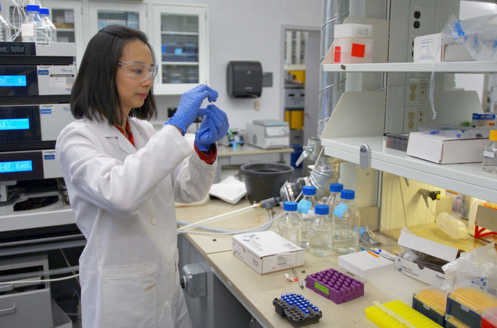Superfund Research Program
High-Fiber Diet May Protect Against Harmful Health Effects of PCBs
View Research Brief as PDF(339KB)
Release Date: 03/04/2020
![]() subscribe/listen via iTunes, download(6.7MB), Transcript(107KB)
subscribe/listen via iTunes, download(6.7MB), Transcript(107KB)
Two new NIEHS-funded Superfund Research Program (SRP) studies showed how a type of dietary fiber, inulin, may protect against heart disease, including heart disease resulting from exposure to polychlorinated biphenyls (PCBs). Inulin is found in vegetables such as asparagus and onions. According to University of Kentucky SRP Center researchers, a diet high in inulin may reduce or modify certain lipids associated with an increased chance of developing cardiovascular problems and may protect against adverse cardiovascular effects caused by environmental toxicants, such as PCBs.
In the first study, researchers led by trainee Pan Deng, Ph.D., and Center Director Bernhard Hennig, Ph.D., used metabolic profiling to analyze the effects of dietary inulin on lipid levels in mice. Hennig’s lab examines how nutrients in the diet affect cardiometabolic toxicity caused by polychlorinated PCBs. Although PCBs were banned decades ago, they can still be released into the environment from hazardous waste sites and persist in the environment. In this study, the researchers examined the mechanisms involved in cardiometabolic toxicity from PCB exposure to see whether inulin could improve outcomes.
Nutrition Studies in Mice
The team used mice lacking receptors for low-density lipoprotein (LDL) and fed them a high-fat diet supplemented with either inulin or a cellulose control. LDL-deficient mice do not adequately clear cholesterol from their blood, making them prone to high cholesterol and atherosclerosis, an inflammatory cardiovascular disease in which fat and cholesterol build up in the walls of arteries.
 Inulin-fed mice had significantly lower levels of all five ceramides at 10 days, A, and three ceramides at 12 weeks, B. (Image from Deng et al., 2020, J Lipid Res)
Inulin-fed mice had significantly lower levels of all five ceramides at 10 days, A, and three ceramides at 12 weeks, B. (Image from Deng et al., 2020, J Lipid Res)At 10 days and 12 weeks, the researchers looked for differences in metabolites and lipids between the two groups.
Inulin significantly decreased the level of ceramides, waxy lipids associated with increased risk of cardiometabolic disease, measured at 10 days and at 12 weeks. Liver samples showed inulin also increased an essential phospholipid, cardiolipin, by more than 43%. Cardiolipin is an important component of mitochondria, which make energy for cells, and regulates several mitochondrial functions.
Drilling Down to Mechanisms
To understand the molecular mechanism by which inulin alters lipid levels, the team analyzed liver samples using transcriptomics. Transcriptomics looks at all RNA molecules involved in gene expression. The group used this technique to understand if the observed differences could be explained by changes in gene expression.
The researchers identified nearly 60 differentially expressed genes in inulin-fed mice compared to controls. One primary function modified by inulin was immune response, including a decrease in expression of genes related to inflammation.
They also found significant changes in genes related to lipid metabolism. One of the key genes identified was Smpd3, which had decreased expression in inulin-fed mice compared to controls. Smpd3 encodes for NSMase, an enzyme that plays an important role in the formation of ceramides. By measuring enzyme activity levels, the team confirmed that NSMase activity was reduced about four-fold in inulin fed-mice compared to controls.
 Deng analyzes samples in the lab. (Photo courtesy of Chad Rumford, University of Kentucky Research Communications)
Deng analyzes samples in the lab. (Photo courtesy of Chad Rumford, University of Kentucky Research Communications)According to the authors, these results explain why inulin-fed mice had lower levels of ceramides. Because high ceramides have been associated with cardiovascular risk, the authors add that a high-fiber diet may protect against heart and metabolic diseases associated with environmental pollutants.
In the second study, led by trainee Jessie Hoffman, the Hennig lab recently confirmed that inulin reduced liver lipid accumulation, protected gut microbiota, and decreased atherosclerosis in mice exposed to PCB 126, pointing to potential nutritional interventions for people who are exposed to PCBs.
For More Information Contact:
Bernhard Hennig
University of Kentucky
Animal and Food Sciences
900 S Limestone St
Lexington, Kentucky 40536-0200
Phone: 859-218-1343
Email: bhennig@uky.edu
To learn more about this research, please refer to the following sources:
- Deng P, Hoffman JB, Petriello MC, Wang C, Li X, Kraemer MP, Morris AJ, Hennig B. 2020. Dietary inulin decreases circulating ceramides by suppressing neutral sphingomyelinase expression and activity in mice. J Lipid Res 61:45-53. doi:10.1194/jlr.RA119000346 PMID:31604806 PMCID:PMC6939596
- Hoffman JB, Petriello MC, Morris AJ, Mottaleb MA, Sui Y, Zhou C, Deng P, Wang C, Hennig B. 2020. Prebiotic inulin consumption reduces dioxin-like PCB 126-mediated hepatotoxicity and gut dysbiosis in hyperlipidemic Ldlr deficient mice. Environ Pollut 261:114183. doi:10.1016/j.envpol.2020.114183 PMID:32105967 PMCID:PMC7220843
To receive monthly mailings of the Research Briefs, send your email address to srpinfo@niehs.nih.gov.


